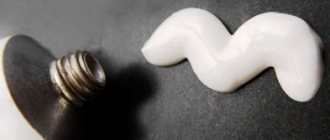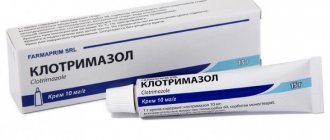Clotrimazole during pregnancy
If you notice symptoms of genital infections while carrying a baby (burning, itching, a large amount of cheesy discharge or irritation, swelling of the genital mucosa), you should consult a doctor to prescribe the correct treatment. You should not delay visiting a specialist - this disease, caused by the Candida fungus and provoked by changes in hormonal levels, can jeopardize pregnancy and harm the health of the unborn child. Doctors advise both sexual partners to undergo treatment with Clotrimazole to prevent re-infection.
Composition and release form
This is an antifungal drug from the group of imidazole derivatives, acting locally and having a wide spectrum of action against almost all pathogenic fungi that cause symptoms of infections in humans. The concentration of clotrimazole (active ingredient) in the products is 1%. The composition of the drug and its release form are as follows:
| Release form | Compound |
| Cream 1% in tubes of 20 g | Active ingredient in 1 g: 10 mg clotrimazole; excipients - cetyl alcohol, petroleum jelly, glycerol, Tween-80, nipagin, distilled water. |
| Solution in 15 ml bottles | 1 ml of solution contains: active substance clotrimazole – 10 mg; excipients: isopropyl myristinate, anhydrous ethanol. |
| Vaginal tablets (suppositories) 0.1 g with applicator (pack of 6 pieces) | Active substance: clotrimazole 100 mg; excipients - lactose, corn starch, aerosil, soda, tartaric acid, magnesium stearate. |
| Vaginal cream 1% in tubes of 20 g with applicator | Active substance in 1 g: clotrimazole – 10 mg; excipients – benzyl alcohol, cetostearyl alcohol, euthanol G, polysorbate 60, span 60, synthetic olbrot, purified water. |
How the drug works
The wide spectrum of influence of Clotrimazole is aimed at almost all known bacteria and pathogenic fungi. These include:
- dermatophytes;
- blastomycosis;
- dimorphic fungi;
- yeast mushrooms;
- mold fungi;
- protozoa;
- certain types of gram-positive cocci;
- corynebacteria.
The drug slows down the growth of these microorganisms (has a fungistatic effect). In high concentrations, it harms the cells of fungi and bacteria, damages their membranes and provokes their death, which is associated with a violation of the synthesis of ergosterol (fungicidal effect). By interacting with the enzymes of pathogenic fungal cells, the medicine raises the concentration of hydrogen peroxide to a toxic level, which leads to their destruction. No development of fungal resistance to the drug was detected.
- How to sow carrots so that they sprout in 3 days
- 4 Ways to Get Rid of Acne Scars on Your Face
- Canned tuna salad recipe with photo
Indications for use
After passing the necessary tests, consulting a specialist and making a diagnosis, treatment with Clotrimazole is prescribed. The drug may be effective in the following cases:
- vulvovaginal candidiasis (thrush);
- trichomoniasis;
- fungal diseases of the skin, feet and skin folds;
- different types of lichen;
- superficial candidiasis;
- candidal stomatitis;
- disinfection of the genital tract before childbirth.
Doctors' opinion
Although Clotrimazole is considered a relatively safe medicine, self-medication during gestation is unacceptable. Only after laboratory tests will the doctor be able to accurately determine the source of the problem and select the most effective medicine. When treating thrush in pregnant women, Clotrimazole is considered the most optimal solution.
Don't forget about your sexual partner. He, too, must undergo treatment, otherwise the patient will soon become infected with thrush again from her husband, which is not good during pregnancy. To treat a spouse, doctors recommend using 1% Clotrimazole cream, which should be used to treat the head of the penis and the entrance to the urethra. The duration of therapy is 2-3 weeks.
If, after a course of treatment, the manifestations of thrush in a pregnant woman do not disappear, then it is necessary to contact a specialist again to select a more effective drug or re-treat with Clotrimazole, but in different dosages. Pregnancy is an unfavorable time for experiments; you cannot independently prescribe any medications, even safe ones.
Source
Directions for use and dosage
When treating thrush, the doctor prescribes vaginal cream (ointment) together with tablets. Clotrimazole suppositories during pregnancy are used without using an applicator, before bedtime (the suppository should be inserted as deep as possible inside the vagina). The drug is prescribed as a course in three options:
- Use of suppositories for 6-7 days with a dose of 100 mg.
- Use of suppositories at a dosage of 200 mg for 3 days.
- For mild forms of the disease, a single dose of 500 mg is used.
Additionally, use Clotrimazole ointment or cream during pregnancy, apply it 2-3 times a day for a week, applying it to the affected areas of the external genitalia and mucous membranes. The partner is treated with 1% cream (lubricate the genitals 2 times a day for 7 days). To disinfect the birth canal immediately before the upcoming birth, use a single dose of 200 mg. The final word remains with the doctor.
Clotrimazole during pregnancy 1st trimester
This drug is not prescribed for women during this period - it is a contraindication. This is especially important in the first months of pregnancy. Experts recommend more gentle drugs, for example, Pimafucin, and look at the dynamics. The use of such a potent medicine during this period without a doctor’s prescription is strictly prohibited, since it can harm the fetus or the body of a pregnant woman.
2nd trimester of pregnancy
3 months after conception, it is permissible to treat thrush with Clotrimazole. This is the optimal time to eliminate such unpleasant problems as candidiasis and other fungal infections of the vulva. Depending on the stage of exacerbation of the disease, the doctor will prescribe the form of the drug and its dosage - vaginal suppositories, tablets, ointment or cream. The course of treatment is about 2-3 weeks.
- What awaits working pensioners - changes in the law, the procedure for indexation and increase of pensions
- Stewed soup - step-by-step recipes for cooking with vermicelli, rice or beans
- Setting up a Rostelecom router
Clotrimazole during pregnancy 3rd trimester
During this period, the fight against fungal infections will be the same as in the second trimester, there are no fundamental differences. A repeat course of therapy may be prescribed. At the end of the 3rd trimester of pregnancy, obstetricians use the drug to sanitize the genital tract - this helps to prevent infection during the birth of the child. For this purpose, it is better to use tablets, the dosage of which is prescribed individually.
Indications
Clotrimazole is prescribed in certain cases:
- fungal skin infection;
- fungus located on the folds of the skin and the soles of the feet or nails;
- lichen;
- candidiasis of the external genitalia;
- trichomoniasis;
- sanitation before childbirth.
The drug is available in various forms and dosages. It depends on the type and degree of the disease. These can be: vaginal tablets or suppositories, solution, ointment, cream and even spray.
Side effects and overdose
When using the drug topically and strictly following the instructions, adverse events occur extremely rarely. The frequency of side effects that occur is unknown, but the following conditions on the immune system, skin, and subcutaneous tissues may be observed individually:
- hives;
- fainting;
- arterial hypotension;
- dyspnea;
- rash;
- itching;
- blistering rashes;
- pain or discomfort;
- peeling;
- burning;
- edema;
- irritation.
In case of an overdose of the drug, no complications or life-threatening conditions were identified externally. When ingesting the cream, headache, dizziness, nausea, and vomiting may occur. Such consequences are treated in accordance with the symptoms manifested.
What symptoms appear during pregnancy
The most common companion of a woman during pregnancy is candidiasis or thrush. It appears due to changes in hormonal levels, changes in the microflora of the vagina, the use of hormonal drugs during pregnancy, as well as with weakened immunity.
Candidiasis brings discomfort. The main symptom is white discharge. A woman suffering from thrush experiences pain and itching during urination, burning, and discomfort during sexual intercourse.
In addition, a fungal disease can negatively affect the development of the fetus, so doctors can prescribe the drug Clotrimazole to pregnant women in the first trimester.
Contraindications
The use of Clotrimazole in the 1st trimester of pregnancy is prohibited. A contraindication to the use of the drug is an allergy or sensitivity to its components. When used correctly, the product is completely harmless to mother and child, and completely cures genital infections after undergoing a course of therapy.
Release forms
Clotrimazole is available in a fairly wide dosage form, which makes its use much more convenient:
- Vaginal capsules (tablets). The main active ingredient is clotrimazole. Available in dosages of 100, 200 and 500 mg.
- Ointment with a concentration of 1%. Available for sale in iron tubes of 20 or 30 grams. One gram of the drug contains 10 mg of the main component.
- Cream with a concentration of 1% and 2%. The composition of the drug is almost identical to Clotrimazole ointment. Available in 30 gram tubes.
- 1% solution. Intended for external use or for sanitation under the supervision of a physician.
- Suppositories (vaginal suppositories). Available in a dosage of 500 mg, most often recommended for single use.
Colposcopy during pregnancy: features of the examination
Analogs
In pharmacies you can purchase domestic and foreign analogues of the drug. Before using them, you should consult with your doctor, as their effect may be different. These are medicines such as:
- Clotrimazole-acri;
- Kanizon;
- Candide;
- Mycotrine;
- Candide-B6;
- Kandibene;
- Amyclone;
- Gyne-lotrimin;
- Antifungol;
- Amidyl;
- Yenamazole;
- Candizol;
- Kanesten;
- Lotrimin;
- Faktodin.
Clotrimazole: basic information about the drug and mechanism of action
Clotrimazole ointment is a well-known synthetic antifungal medication from the group of imidazole derivatives for local use. Effective against:
- dermatitis caused by epidermophytons, filamentous and parasitic fungi;
- blastomycosis with damage to lung tissue;
- mushrooms of the genus Candida, Coccidioides, Madurella, Aspergillus, Torulez, Nocardia.
In minimal doses, the mechanism of action is fungistatic (suppresses the growth and reproduction of the pathogen; after discontinuation of the drug, the life activity of the pathogenic agent resumes).
With a long course, a fungicidal effect of the product is observed - the growth and reproduction of fungi completely stops.
Clotrimazole cream inhibits the process of combining fungal sterol, which is part of cell membranes. As a result, their structure and functionality changes.
The dosage of the drug is selected by the doctor individually
Clotrimazole price
Pharmacies in Moscow and St. Petersburg offer drugs of various release forms from domestic and foreign drug manufacturers. Their cost is as follows:
| Release form | Price |
| Clotrimazole tab. vag. 100 mg N6 | 12-45 rub. |
| Clotrimazole ointment tube 1% 20 g | 22-59 rub. |
| Clotrimazole cream tube 1% 20 g | 28-165 rub. |
| Clotrimazolfl. 1% 15 ml | 150-175 rub. |
| Clotrimazole 1% gel 20 g | 20 rub. |
Features of application
Medicines in the form of ointments or creams are not used to treat the skin around the eyes and its mucous membranes.
If an allergic reaction develops, stop using the drug.
If there is no therapeutic effect a month after starting to use the drug, you should re-take tests and confirm the correctness of the diagnosis. A swab is performed to confirm the presence of yeast by culturing it in a microbiology laboratory.
Clotrimazole is not an antimicrobial drug; its action is aimed at eliminating an infection caused not by bacteria, but by protozoan organisms - a fungus.
Source: shejka-matki.ru











